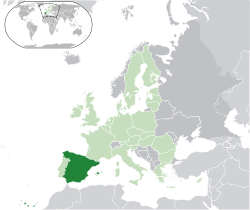Spain On Verge Of €300 Billion Bailout
By EurActiv
(EurActiv) — Spain has for the first time conceded it might need a full bailout worth €300 billion if its borrowing costs remain unsustainably high, a eurozone official said.
Economy Minister Luis de Guindos brought up the issue with German counterpart Wolfgang Schäuble in a 24 July meeting in Berlin as Spain’s borrowing costs soared past 7.6%, the source said.
If needed, the money would come on top of the €100 billion already agreed to prop up Spain’s banking sector, stretching the eurozone’s resources to breaking point, and Schäuble told de Guindos he was unwilling to consider a rescue before the currency bloc’s bailout fund – the European Stability Mechanism, or ESM – comes on line later this year.

“De Guindos was talking about €300 billion for a full programme, but Germany was not comfortable with the idea of a bailout now,” the official told Reuters.
“Nothing will happen until the ESM is online. Once it is operational we will see what the borrowing costs for Spain are and maybe we will return to the question,” the official said.
Spain has repeatedly said it would not need to follow Portugal, Ireland and Greece in seeking a full bailout. Asked about the source’s comments, a government spokeswoman said today (27 July): “We strongly deny any such plan. This possibility [of a €300-billion rescue for Spain] has not been looked at and has not been discussed.”
As Schäuble and de Guindos were meeting on Tuesday, Spanish borrowing costs reached their highest level since the country adopted the euro, hitting 7.64% for 10-year bonds – a level at which Spain cannot sustainably borrow from the markets.
But on Thursday European Central Bank President Mario Draghi said the central bank was ready to act to bring down Spanish yields and the 10-year yield fell to 6.88%.
A second eurozone official said Spain could manage without a bailout, but had made bad communication mistakes which had unnerved investors. Asked if Madrid needed a bailout the second official said: “In pure arithmetic terms no, if interest rates were commensurate with what I consider a sustainable situation.”
Rescue funds under pressure
Draghi’s move to talk down markets is the biggest signal yet that officials are now fully-focussed on preventing investor pressure on Spain from forcing the eurozone into a full formal bailout.
A temporary bailout fund, the European Financial Stability Facility, has €259.5 billion of lending capacity left, of which up to €100 billion is already earmarked for the recapitalisation of Spain’s stricken banks.
The ESM is expected to come into operation in mid-September. It will have a total capacity of €500 billion, although it was initially planned that it would only build up this amount over a few years.
That means that coupled with the bank recapitalisation loan, a full bailout runs the danger of exhausting the eurozone’s rescue capacity, prompting fresh discussions of the idea of granting the ESM a banking licence, the official said.
Called for by France but so far opposed by the ECB and Germany as well as Finland and the Netherlands, such a licence would give the ESM virtually unlimited intervention capacity because it could fund itself at the ECB’s liquidity operations.
Governing Council member Ewald Nowotny offered markets some hope of a softening of the ECB’s position earlier this week, saying it had its merits.
Spokesmen for both the Bundesbank and Schäuble firmly restated their opposition on Friday but the question remains of how the ESM would fund a Spanish bailout in practice, should it prove necessary.
“I believe it is no accident that Nowotny mentioned that – he was sending up a test balloon. And the silence afterwards [from opponents of the idea] was telling,” the first eurozone official told Reuters.
“I feel that the Germans are changing their position on this, they are scared, and with good reason, and their opposition is softening,” the official said.
